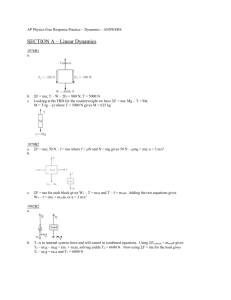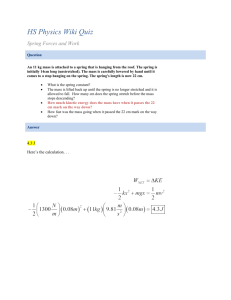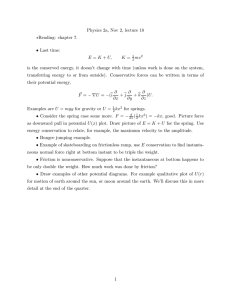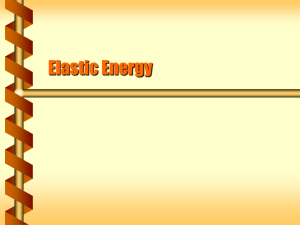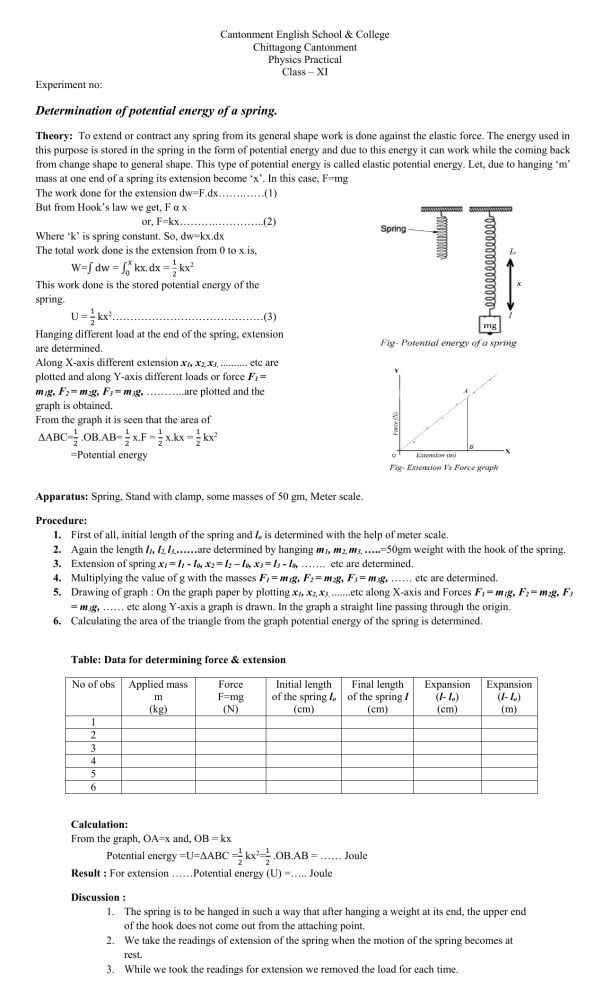
Cantonment English School & College Chittagong Cantonment Physics Practical Class – XI Experiment no: Determination of potential energy of a spring. Theory: To extend or contract any spring from its general shape work is done against the elastic force. The energy used in this purpose is stored in the spring in the form of potential energy and due to this energy it can work while the coming back from change shape to general shape. This type of potential energy is called elastic potential energy. Let, due to hanging ‘m’ mass at one end of a spring its extension become ‘x’. In this case, F=mg The work done for the extension dw=F.dx…….……(1) But from Hook’s law we get, F α x or, F=kx……….…………..(2) Where ‘k’ is spring constant. So, dw=kx.dx The total work done is the extension from 0 to x is, 𝑥 1 W=∫ dw = ∫0 kx. dx = 2 kx2 This work done is the stored potential energy of the spring. 1 U = 2 kx2……………………………………(3) Hanging different load at the end of the spring, extension are determined. Along X-axis different extension x1, x2, x3, .......... etc are plotted and along Y-axis different loads or force F1 = m1g, F2 = m2g, F3 = m3g, ………..are plotted and the graph is obtained. From the graph it is seen that the area of 1 1 1 1 ΔABC=2 .OB.AB= 2 x.F = 2 x.kx = 2 kx2 =Potential energy Apparatus: Spring, Stand with clamp, some masses of 50 gm, Meter scale. Procedure: 1. First of all, initial length of the spring and lo is determined with the help of meter scale. 2. Again the length l1, l2, l3,……are determined by hanging m1, m2, m3, …..=50gm weight with the hook of the spring. 3. Extension of spring x1 = l1 - l0, x2 = l2 – l0, x3 = l3 - l0, ……. etc are determined. 4. Multiplying the value of g with the masses F1 = m1g, F2 = m2g, F3 = m3g, …… etc are determined. 5. Drawing of graph : On the graph paper by plotting x1, x2, x3, .......etc along X-axis and Forces F1 = m1g, F2 = m2g, F3 = m3g, …… etc along Y-axis a graph is drawn. In the graph a straight line passing through the origin. 6. Calculating the area of the triangle from the graph potential energy of the spring is determined. Table: Data for determining force & extension No of obs Applied mass m (kg) Force F=mg (N) Initial length of the spring lo (cm) Final length of the spring l (cm) Expansion (l- lo) (cm) Expansion (l- lo) (m) 1 2 3 4 5 6 Calculation: From the graph, OA=x and, OB = kx 1 1 Potential energy =U=ΔABC =2 kx2=2 .OB.AB = …… Joule Result : For extension ……Potential energy (U) =….. Joule Discussion : 1. The spring is to be hanged in such a way that after hanging a weight at its end, the upper end of the hook does not come out from the attaching point. 2. We take the readings of extension of the spring when the motion of the spring becomes at rest. 3. While we took the readings for extension we removed the load for each time.
